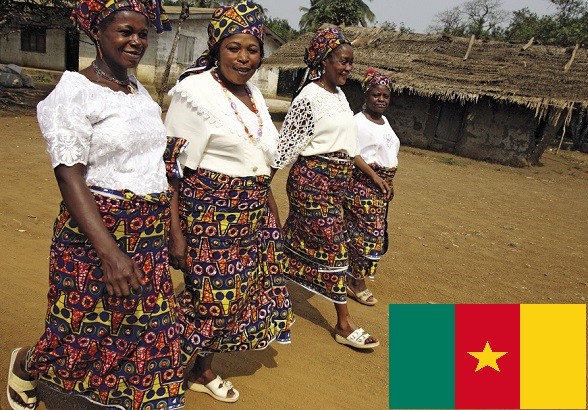General Country Information:
- Official Name: Republic of Cameroon
- Capital City: Yaoundé
- Official Languages: French and English
- Currency: Central African CFA Franc (XAF)
- Government Type: Unitary Presidential Republic
Geographical Location:
- Continent: Africa
- Neighboring Countries: Nigeria to the west, Chad to the northeast, Central African Republic to the east, Republic of Congo, Gabon, and Equatorial Guinea to the south.
- Major Cities: Yaoundé, Douala, Garoua, Bamenda, Maroua
Brief History and Political Overview:
- History: Cameroon was colonized by Germany in the late 19th century. After World War I, it was divided between France and Britain under League of Nations mandates. It gained independence in 1960, with the French-administered part becoming the Republic of Cameroon, and the British-administered part (Southern Cameroons) joining later in 1961.
- Political Overview: Cameroon has been led by President Paul Biya since 1982, making him one of the longest-serving presidents in Africa. The country has experienced political tension, especially in the Anglophone regions, where there have been calls for independence.
- Current Leaders:
- President: Paul Biya
- Prime Minister: Joseph Dion Ngute
- Significant Historical Events: Independence from France in 1960, reunification with British Southern Cameroons in 1961, ongoing Anglophone crisis since 2016.

Map of Cameroon
Religions and Cultural Highlights:
- Religions: Christianity (Roman Catholic and Protestant) is the predominant religion, with Islam and indigenous beliefs also present.
- Cultural Highlights: Cameroon is often referred to as “Africa in miniature” due to its diverse geography and cultural variety. The country is known for its traditional dances, music, and arts. The annual Mount Cameroon Race of Hope is a significant event.
Economy
GDP:
- Latest Available Data (2023): $47.95 billion USD (2023, World Bank)
Major Industries:
- Agriculture (cocoa, coffee, bananas, palm oil)
- Oil and gas
- Timber
- Mining
- Manufacturing (aluminum, food processing, textiles)
- Services (tourism, telecommunications)
Key Economic Indicators:
- GDP Growth Rate: 3.8% (2023, AFDB)
- Inflation Rate : 5.5% (2024, IMF)
- Poverty Levels: Approximately 37.5% of the population lives below the national poverty line. (CIA Factbook)
- Investment Climate: Cameroon has a mixed investment climate with challenges including bureaucratic delays, corruption, and infrastructure deficits. However, there are opportunities in energy, mining, and agriculture.
See this Marketing Guide to Streamlining Your Workflow
Trade Statistics:
- Main Export Partners: China, Italy, Netherlands, Spain, France
- Main Import Partners: China, France, Nigeria, Belgium, United States
- Major Export Goods: Crude oil, timber, cocoa, aluminum, coffee, cotton
- Major Import Goods: Machinery, electrical equipment, vehicles, fuels, foodstuffs
Currency and Exchange Rates:
- Currency: Central African CFA Franc (XAF)
- Exchange Rate (August 2024): 1 USD ≈ 600 XAF
Population
Total Population:
- Latest Available Data : 30.9 million (2024, CIA Factbook)
- Population Growth Rate : 2.71% (2024, CIA Factbook)
- Demographic Trends: Cameroon has a young population with a high birth rate. Urbanization is increasing, particularly in Douala and Yaoundé.
Age Distribution:
- 0-14 years: 42%
- 15-24 years: 19%
- 25-54 years: 30%
- 55-64 years: 5%
- 65 years and over: 4%

2023 Population Pyramid
Urban vs. Rural Population Distribution:
- Urban: 56%
- Rural: 44%
Major Ethnic Groups and Population Diversity:
- Cameroon is ethnically diverse with over 250 ethnic groups, including the Beti, Bamileke, Bassa, Kirdi, and Fulani.
Education Levels and Literacy Rates:
- Literacy Rate: 77.1% (2023, CIA Factbook)
- Education Levels: Primary education is compulsory, but secondary and tertiary education enrollment rates are lower, especially in rural areas.
Workforce
Labor Force Size and Composition:
- Labor Force Size : 11.965 million (2023, CIA Factbook)
- Composition by Sector:
- Agriculture: 47%
- Industry: 14%
- Services: 39%
- Unemployment Rate : 3.65% (2023, CIA Factbook)
Workforce Skills and Education:
- Cameroon’s workforce is primarily engaged in agriculture, with increasing opportunities in services and industry. However, skills mismatches and low levels of technical education remain challenges.
Labor Laws and Worker Rights:
- Cameroon has labor laws that protect workers’ rights, including minimum wage regulations, work hour restrictions, and the right to unionize. However, enforcement can be inconsistent.
Migration Trends:
- Inward Migration: Cameroon hosts refugees from neighboring countries, including Nigeria and the Central African Republic.
- Outward Migration: Cameroonians migrate mainly to Europe and the United States for better opportunities.
Natural Resources
List of Major Natural Resources:
- Oil and Gas
- Timber
- Bauxite
- Iron Ore
- Gold
- Diamonds
Top Minerals (in order of economic importance):
- Oil
- Bauxite
- Iron Ore
- Gold
- Diamonds
Annual Production Volumes for Key Minerals:
- Oil (2023): Approximately 70,000 barrels per day
- Bauxite: Data not readily available
- Iron Ore: Data not readily available
- Gold: Data not readily available
- Diamonds: Data not readily available
Update on Renewable Energy: Cameroon has significant potential for hydroelectric power and has been investing in renewable energy projects, including small hydropower plants and solar energy initiatives. The government aims to increase renewable energy’s share in the national energy mix.
Mining and Natural Resources Laws and Regulations
Key Laws Governing Mining and Natural Resource Utilization:
- Mining Code (2016): Governs the exploration, extraction, and management of mineral resources in Cameroon. [https://www.minmidt.cm/wp-content/uploads/2018/01/mining_code_2016_part01.pdf]
- Petroleum Code (1999): Regulates oil and gas exploration and production. [https://minepded.gov.cm/wp-content/uploads/2020/01/LAW-NO.-99013-OF-22-DECEMBER-1999-TO-INSTITUTE-THE-PETROLEUM-CODE-EXCERPT.pdf]
Regulatory Bodies and Their Roles:
- Ministry of Mines, Industry, and Technological Development: Oversees the mining sector.
- National Hydrocarbons Corporation (SNH): Manages the oil and gas industry on behalf of the state.
Recent Changes in Legislation:
- In recent years, Cameroon has made efforts to modernize its mining code to attract foreign investment, emphasizing environmental protection and local community development.
Sources:
- World Bank [https://www.worldbank.org/]
- CIA World Factbook [https://www.cia.gov/the-world-factbook/countries/cameroon/]
- African Development Bank [https://www.afdb.org/en/countries-central-africa-republic-cameroun/cameroon-economic-outlook]
- National Institute of Statistics, Cameroon [http://www.statistics-cameroon.org/]
- Ministry of Mines, Industry, and Technological Development [http://www.minmidt.cm/]
